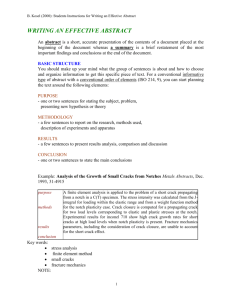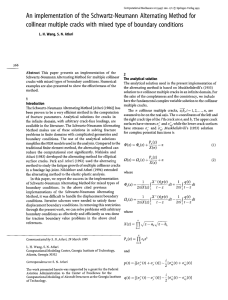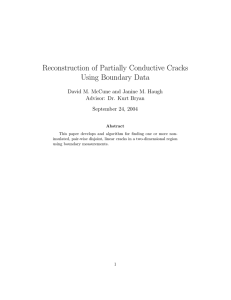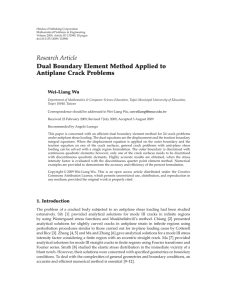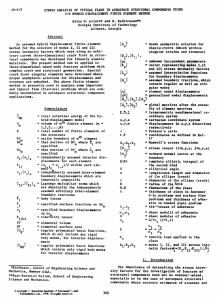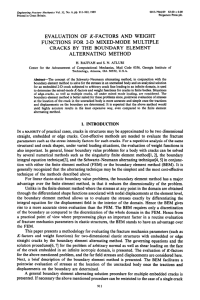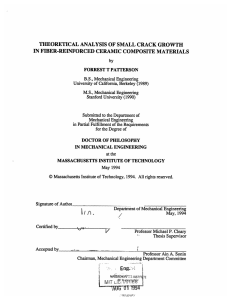Periodic Array of Partially Insulated Interface Noah Weiss Joint Mathematics Meetings 2016
advertisement
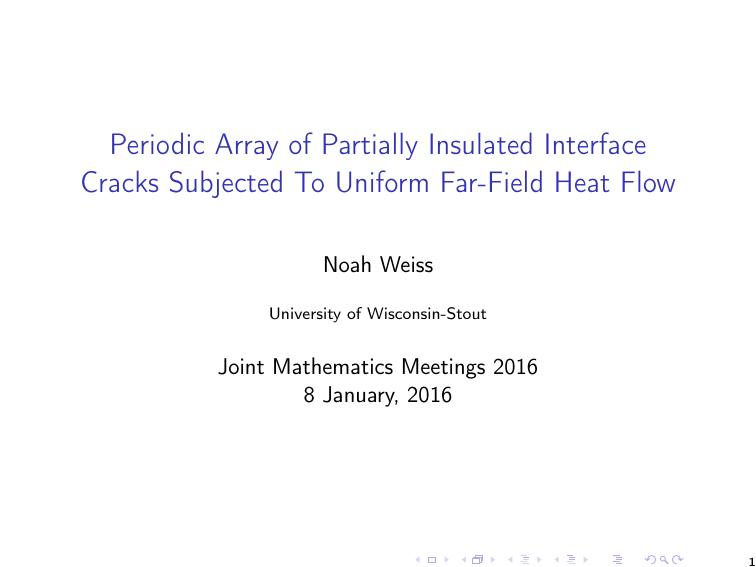
Periodic Array of Partially Insulated Interface
Cracks Subjected To Uniform Far-Field Heat Flow
Noah Weiss
University of Wisconsin-Stout
Joint Mathematics Meetings 2016
8 January, 2016
1
Introduction
I
Interface cracks appear in geology, strength of materials,
coating, and other areas
I
Interface crack: A cut or hole on the interface between
dissimilar materials (half-spaces)
q
ν+
µ+
y
k+
S + = {(x, y) : y > 0}
α+
x
(−a, 0) (a, 0)
ν−
µ−
k−
S − = {(x, y) : y < 0}
α−
q
2
Introduction
I
Goal: Find the stresses in the material due to the crack, given
loading conditions
I
Of particular interest: The coefficient of the singular term near
the crack tips
I
Existing literature: Thermal and/or mechanical loading in far
field; isolated cracks
I
I
Appears to contradict the far-field assumption when the crack
size is only length scale
Real materials will often have multiple cracks
3
Simplified equations of thermoelasticity
I Equilibrium equations
∂σxx (x, y )
∂σxy (x, y )
+
=0
∂x
∂y
∂σ (x, y )
∂σxy (x, y )
xx
+
=0
∂x
∂y
I Displacement-strain conditions
∂u (x, y )
;
xx (x, y ) =
∂x
∂v (x, y )
1 ∂u (x, y )
xy (x, y ) =
+
2
∂y
∂x
yy (x, y ) =
∂v (x, y )
∂y
I Hooke’s law (stress-to-strain)
2µ
σxx (x, y ) = 2µxx (x, y ) +
(ν (xx (x, y ) + yy (x, y )) − α∗ T (x, y ))
1 − 2ν
2µ
σyy (x, y ) = 2µyy (x, y ) +
(ν (xx (x, y ) + yy (x, y )) − α∗ T (x, y ))
1
−
2ν
σxy (x, y ) = 2µxy (x, y )
I Conservation of energy
∇2 T (x, y ) = 0
4
Heat transfer problem and boundary conditions
I
I
I
Elasticity and conservation of energy uncoupled
Heat transfer: Laplace’s equation with boundary conditions
Consider periodic array of interface cracks
y
Q
∗
S + : ν+ , µ+ , α+
, k+
`π
δ
Bond
Crack
x
(a, 0)
∗
S − : ν− , µ− , α−
, k−
Q
5
Procedure for solution
I
Solution of Laplace’s equation is real part of holomorphic
function θ± (z) where z = x + iy
I
Boundary conditions allow use of analytic continuation to get
sectionally holomorphic function
I
Map from periodic strip to full complex plane using
ζ = tan (z/`)
6
Mapping
Original domain - one period
Mapped domain
y
η
ζ = 0+ + iη
(x = (π`/2)− )
ζ = 0− + iη
(x = (−π`/2)+ )
x = −`π/2
z = −`π/2
(ζ = ∞)
S+ : y > 0
∗
µ+ , ν+ , α+
, k+
x = `π/2
ζ=i
(y = ∞)
Ŝ + : η > 0
∗
µ+ , ν+ , α+
, k+
ξ
x
2a
S− : y < 0
∗
µ− , ν− , α−
, k−
Ŝ − : η < 0
∗
µ− , ν− , α−
, k−
2â
ζ = −i
(y = −∞)
−
ζ = 0 + iη
(x = (−π`/2)+ )
ζ = 0+ + iη
(x = (π`/2)− )
Thermal solution
I
Prescribed flux on crack and periodicity condition: leads to
0 (ζ)
Riemann-Hilbert problem for θ±
I
Solve with contour integration; use boundary conditions
Find an appropriate antiderivative to find the temperature
potential:
I
θ± (z) = i
`Q
k±
x cos (z/`)
(1 − δ) sgn sin
arcsin
`
cos (a/`)
π` − x
1
z
−
−δ
+π
π`
2
`
8
Interaction of heat fluxes
Heat fluxes for ∆=0 and single crack
Heat fluxes for ∆=0 with periodic boundary conditions
y
Y
2
2
1
1
0
X 0
-1
-1
x
-2
-2
-1.5
-1.0
-0.5
0.0
0.5
1.0
1.5
-1.5
-1.0
-0.5
0.0
0.5
1.0
1.5
9
Thermoelastic problem; boundary conditions
I
Using Airy stress potentials, the governing equations reduce to
the biharmonic equation
∇4 φ(±) = 0
I
I
Conversion into complex variables gives two arbitrary
potentials per region
Boundary conditions:
No traction and xx → 0 far from crack
x = π`/2
x = −π`/2
∗
S̃ + : µ+ , ν+ , α+
, k+
Stresses
periodic
Displacements and
across
strip edges tractions continuous
across bond
Crack
Displacements and
tractions continuous
across bond
Stresses
periodic
across
strip edges
∗
S̃ − : µ− , ν− , α−
, k−
10
Riemann-Hilbert problem
I
I
Boundary conditions allow use of analytic continuation to
reduce to one potential
Standard crack condition: Zero tractions
I
R-H problem becomes:
Ξ̂+ (τ ) + β Ξ̂− (τ ) = i2 ϑ+ Â+ (τ ) + βϑ− Â− (τ )
+ (1 + κ+ + (1 + β) Γ) c0∗ ;
I
|τ | < â
where
√
 (ζ) = i (1 − δ) log
1 + â2 + iζ
q
1 + iζ
1−
â2
ζ2
11
Results for traction free cracks
I
I
Scaled elastic field depends on δ, L, β (dissimilarity of
materials), ϑ (distortivity ratio)
Crack opening displacement, stress intensity factors, and
energy release rates
ˆx n
o
(+)
(−)
∆v (x) =
v,x t, 0+ − v,x t, 0− dt
−a
K ∗ = lim+ (ξ − â)−iγ
ξ→â
p
∗
∗
2π (ξ − â) σ̂yy
+ i σ̂xy
ξ − â, 0+
G ∗ = (1 + β) |K ∗ |2 sech2 (πγ) /16
I
Parameters used for opening and bond stresses: δ = 1/3,
L = 1/4, β = 9/10, ϑ = 1/20
I
Approximately corresponds to lead/silver
12
Crack opening displacements (scaled by 1/ (aϑ− ))
13
Dimensionless stress intensity factors and energy release
rates
(β, ϑ)
(.9, .05)
(.9, .25)
(.9, .5)
(.9, .9)
(.95, .95)
(.99, .99)
10K ∗
1.64 + 1.57i
1.31 + 1.92i
.896 + 2.35i
.237 + 3.04i
.116 + 3.04i
.023 + 3.05i
103 G ∗
6.01
6.39
7.49
11.0
11.3
11.6
14
Limiting cases: Identical materials or long periods
I
If ϑ and β each approach 1, stress distributions reduce to
known result
I
I
I
I
Heat flow does not open the crack (i.e. ∆v = 0 on all cracks)
Thus the stress intensity factor is Mode II (sliding) only
All far-field tractions vanish as expected
If ` → ∞ (for dissimilar materials), an isolated-crack problem
with vanishing tractions at infinity is well-defined
15
Reversed heat flow
I
Reversed heat flow: Same boundary conditions would imply
interpenetration of crack faces
I
Boundary conditions must change–assume frictionless contact
on crack face
I
The R-H problem then has a simple square root singularity
I
Traction on the crack should be compressive (negative)
16
Reversed heat flow: Interfacial normal traction for copper
and aluminum
Scaled normal traction on crack
Scaled normal traction on interface
0.5
0.5
1
-0.5
-1.0
-1.5
-2.0
2
3
4
5
6
X
-1.0
0.5
-0.5
-0.5
-1.0
-1.5
-2.0
-2.5
X
1.0
Conclusions
I
Deflection of heat flows interact between periods
I
A stress intensity factor for thermal interface cracks can be
defined to model material strength
I
Period’s length scale extends to well-defined isolated crack case
I
Both open and closed crack cases reduce to known symmetric
results when materials are identical
18




